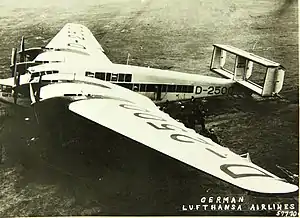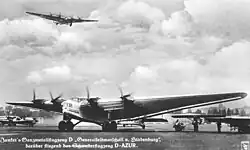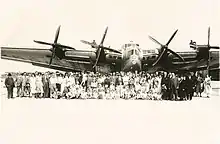Junkers G.38
The Junkers G.38 was a large German four-engined transport aircraft which first flew in 1929.[1] Two examples were constructed in Germany. Both aircraft flew as a commercial transport within Europe in the years leading up to World War II.
| G.38 | |
|---|---|
 | |
| Role | Transport |
| Manufacturer | Junkers |
| First flight | 6 November 1929 |
| Primary users | Luft Hansa Luftwaffe |
| Number built | 2 |
| Variants | Mitsubishi Ki-20 |
During the 1930s, the design was licensed to Mitsubishi, which constructed and flew a total of six aircraft, in a military bomber/transport configuration, designated Ki-20.[2]
The G.38 carried a crew of seven. Onboard mechanics were able to service the engines in flight[1] due to the G.38's blended wing design, which provided access to all four power plants.
Design and development

During the 1920s, Hugo Junkers made several attempts to produce a large scale commercial transport. His initial attempt, the four-engined JG1, was developed during 1921-1922; but Junkers was forced to destroy the incomplete airplane based on post-WWI Allied demands citing the Treaty of Versailles. Later in the decade, in 1925, he published design specifications for a proposed eighty passenger trans-Atlantic aircraft - the J.1000 project. Then again, towards the end of the decade, the G.40 project was started by the Junkers design team as a trans-Atlantic mail plane. From the G.40 design, which was a seaplane configuration, Junkers also developed a landplane design, designated the G.38. Despite interest from the German armed forces in the G.40 variant, Junkers pushed forward with the landplane design which, having received financing from the Reich Air Ministry (Reichsluftfahrtministerium), was taken forward to the construction stage.
The first Junkers prototype—3301 and marked as D-2000—first flew on 6 November 1929 with four diesel engines: two Junkers L55 V-12 engines and two 294 kW L8 inline-6 engines, with a total power rating of 1470 kW (1971 hp).[3] The Reich Air Ministry purchased the D-2000 for demonstration flights,[4] and took delivery on 27 March 1930. In flight tests, the G.38 set four world records including speed, distance and duration for airplanes lifting a 5000 kg payload.[1] On 2 May 1930 Luft Hansa put the D-2000 into commercial service for both scheduled and chartered flights.
Structurally the G.38 conformed to standard Junkers' practice, with a multi-tubular spar cantilever wing covered (like the rest of the aircraft) in stressed, corrugated duraluminium. The biplane tail, found in other large aircraft of the time, was intended to reduce rudder forces; initially there were three rudders with only a central fixed fin. The undercarriage was fixed, with double tandem main wheels that were initially enclosed in very large spats. The wing had the usual Junkers "double wing" form, the name referring to the full span movable flaps which served also as ailerons in the outer part.

On 2 February 1931 the Leipzig-based Junkers' yard re-engined the D-2000 with two Junkers L8 and two L88 engines, giving a total power rating of 1764 kW (2366 hp) and increasing passenger capacity from 13 to 19.[3]
During its early life the G.38 was the largest landplane in the world.[1] Passenger accommodation was sumptuous by today's standards and was meant to rival that found on the competing Zeppelin service offered by DELAG. The plane was unique in that passengers were seated in the wings, which were 1.7 m (5 ft 7 in) thick at the root.[5] There were also two seats in the extreme nose. The leading edge of each wing was fitted with sloping windscreens giving these passengers the forward-facing view[1] usually available only to pilots. There were three 11-seat cabins, plus smoking cabins and washrooms.
In design terms the G-38 followed the Blended Wing Body design pioneered by Louis de Monge, later followed by Vincent Burnelli in his UB14 and later CBY-3 designs, and even later considered by both NASA and Boeing as an alternative to traditional tube and wing aircraft configurations.

Operational history
On 1 July 1931 Luft Hansa initiated regularly scheduled service between Berlin and London on flights carrying up to 13 passengers.[1] This London-Berlin service was halted in October 1931 to retrofit the aircraft and expand the passenger cabin of the D-2000. Construction lasted from this time until mid-1932, during which a second deck was built within the D-2000's fuselage—enabling an increased cargo capacity and seating for up to 30 passengers. Additionally the D-2000's engines were again upgraded to four L88s, giving a total power of 2352 kW (3154 hp). Also at this time the D-2000's registration was changed to D-AZUR.
Meanwhile, a second G.38—factory number 3302 and c/n D-2500, later changed to D-APIS—was built with a double deck fuselage and capacity for 34 passengers. Six passengers were carried three per wing in each leading edge, the remaining 22 on two levels in the fuselage. Luft Hansa used D-APIS on a scheduled service covering the cities Berlin, Hanover, Amsterdam, and London. This aircraft was named General Feldmarschall von Hindenburg.
In 1934 D-2000/D-AZUR had its engines upgraded, this time with Jumo 4 engines, giving a total power rating of 2208 kW (2960 hp).[6]
Both planes were in service simultaneously until 1936, when D-AZUR crashed in Dessau during a post-maintenance test flight. Luft Hansa had to write off this aircraft due to the extensive damage, but test pilot Wilhelm Zimmermann survived the crash, and there were no other casualties.
The second G.38—marked D-2500 and later D-APIS—flew successfully within the Deutsche Luft Hansa fleet for nearly a decade. With the outbreak of World War II the D-2500/D-APIS was pressed into military service as a transport craft by the Luftwaffe. It was destroyed on the ground during an RAF air raid on Athens on 17 May 1941.[1][7]
Specifications (G.38 1929)

General characteristics
- Crew: 7
- Capacity: 30 (D-2000/D-AZUR) and 34 (D-2500/D-APIS) passengers[3]
- Length: 23.21 m (76 ft 2 in) [3]
- Wingspan: 44 m (144 ft 4 in)
- Height: 7.2 m (23 ft 7 in) [1]
- Wing area: 290 m2 (3,100 sq ft) [1]
- Empty weight: 14,920 kg (32,893 lb) [3]
- Gross weight: 24,000 kg (52,911 lb)
- Max takeoff weight: 21,240 kg (46,826 lb) [1][3]
- Powerplant: 2 × Junkers L88 V-12 water-cooled Diesel piston engines inboard
- Powerplant: 2 × Junkers L8a six-cylinder, water-cooled, in-line Diesel piston engines, 308 kW (413 hp) each at take-off, outboard
- Propellers: 2-bladed wooden fixed pitch propellers outboard, 4-bladed wooden fixed pitch propellers inboard
Performance
In popular culture
The G.38 was featured in the 2013 semi-fictional movie ''The Wind Rises'' by Japanese director Hayao Miyazaki, as was Hugo Junkers.[8]
See also
Related development
Aircraft of comparable role, configuration, and era
References
Notes
- EADS
- Schnaedelbach
- Junkers
- G38 Special, translated: "ten hour flight with press on board over Germany; a round Europe flight to eleven capitals and showing the airplane to prominent business people and politicians"
- Turner, P. St.J, & Nowarra, H. Junkers: an aircraft album (1971). New York:Arco Publishing Inc
- "Longer Range of Diesel Plane Cuts Fuel Cost". Popular Mechanics, December 1935.
- Junkers, G38 Special
- "ZOOM Plane and not so simple - The Boston Globe". BostonGlobe.com. Retrieved 2017-05-05.
Bibliography
- "Junkers G 38". EADS. 2007-10-11. Archived from the original on 2009-03-30. Retrieved 2007-11-26.
- translated by Dr. Oliver Schnaedelbach. "Junkers G-38". The 20-2-40 Style Syndicate. Retrieved 2007-11-26.
- Junkers-G38 Archived 2018-09-05 at the Wayback Machine junkers.de (German)
- G38 Special: Fliegendes Hotel: Die Junkers G 38 junkers.de (German)
External links
- Movie of the first test flight of the G38 D-2000
- "Huge Plane Carries Passengers In Wings" Popular Mechanics, February 1930
- "Passengers Ride in Wings of Biggest Land Plane". Popular Science Monthly: 43. February 1930.
- "Huge Plane Takes Crew Under Its Wing", January 1931, Popular Mechanics article includes photo and cutaway drawing
- "Giant Of The Air - The Latest German Liner", January 1933, Popular Mechanics cutaway drawing of G.38 better than 1931 article
- Photo of D-APIS in Greece in 1941